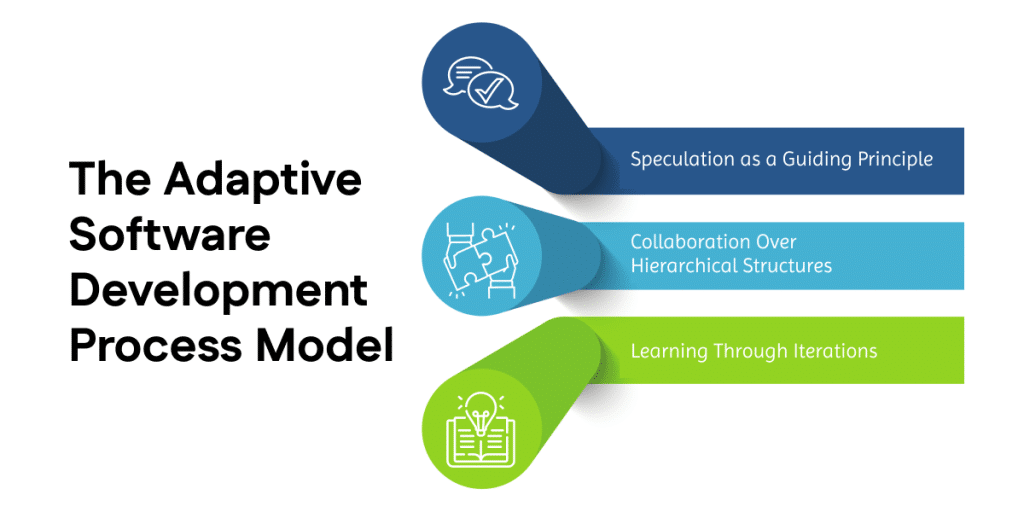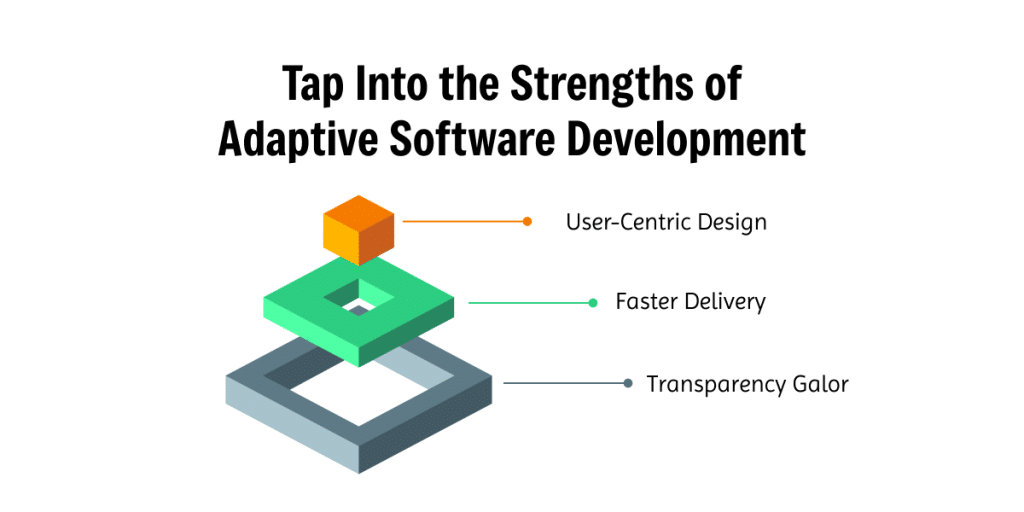Change is the only constant and change is inevitable, especially in software development. It is through Adaptive Software Development (ASD) that can help you stay ahead by embracing change and turning it into opportunity. Wondering what is adaptive software development is? It’s the key to thriving in a world where change is inevitable. This is a methodology that allows your software to adapt and evolve as technologies and user needs change.
What if I told you that your software could be as fast as the changes happening around you, unlike traditional development methods that used to predict every possible outcome before starting! ASD welcomes change. Software can still stay updated because ASD is designed in a way to respond to evolving requirements, new technologies, and user feedback throughout the Software development cycle.
The Adaptive Software Development Process Model

To truly grasp what Adaptive Software Development (ASD) is all about, let’s understand its core principles: speculation, collaboration, and learning. These elements allow teams to navigate the unpredictable world of software development without tripping over their own feet.
-
Speculation as a Guiding Principle
Forget about creating a detailed blueprint and hoping it holds up ASD embraces flexible thinking with informed guesses, not just static plans. Instead of rigid upfront planning, teams engage in speculation, making well-informed guesses about the road ahead and adjusting as new information rolls in.
Example:
Imagine a company building a smart home thermostat. At first, they speculate that consumers will want voice control, app integration, and energy savings. As the project progresses, user feedback shows a desire for more eco-friendly features and the team pivots to include solar panel integrations. Thanks to speculation, they stay flexible and adjust their product to meet evolving market trends. This flexibility is a major reason why ASD is favored in uncertain and fast-moving industries like tech startups.
Also Read : 12 Best System Development Methodology
-
Collaboration Over Hierarchical Structures
In ASD, the idea of the lone genius at the top of the pyramid is thrown out the window. Collaboration takes center stage, where developers from designers to designers work together, sharing ideas and expertise, making sure every aspect of the software hits the mark.
Example:
In a project to build a new e-commerce platform, the development team isn’t calling all the shots. Designers, UX specialists, and product managers come together to ensure that the website not only functions smoothly but also align with business goals. The result? A product that doesn’t just work but it delights.
A 2017 study by Scrum Alliance showed that teams working with collaborative methods in agile environments had 25% better customer satisfaction scores compared to those using traditional methods, highlighting the importance of cross-functional collaboration.
-
Learning Through Iterations
Instead of building a product in one big, risky leap, ASD breaks it down into manageable chunks—iterations—that allow teams to gather feedback, learn and then refine the product as they go. Every cycle is a chance to improve. Iterations equal to learning.
Example:
A mobile app development team releases the first version of the app, featuring core functions like user sign-in, profiles and push notifications. They gather feedback and users request a dark mode. The next iteration includes this feature, along with a bug fix for profile syncing. This continuous improvement cycle with adaptive software development ensures the app gets better and better, one user insight at a time.
Tap Into the Strengths of Adaptive Software Development

- User-Centric Design: ASD keeps the end user at the forefront, where creating products that not only meet the needs but surprises them with intuitive features. Software evolves based on direct user feedback.
Suppose some users get lost in a sea of data while searching for something in dashboards, trying to find the right analytics. But the ASD design includes customizable dashboards so it’s possible to revamp the design and is easier for them to pick the metrics they want.
- Faster Delivery: With adaptive software development, you do not have to keep waiting around for months. This approach can deliver on time or even ahead of schedule, without sacrificing quality.
A CRM software team can embrace ASD and with a swift approach, it can turn a standard deadline into an unexpected win. Their quick iteration and feedback-driven process deliver results faster than expected, without compromising the quality.
- Transparency Galore: Say goodbye to communication breakdowns! This feature-driven development fosters a level of transparency between developers and clients that makes everyone feel in the loop, every step of the way.
Forget playing the guessing game where real-time tracking is right on your screen! With tools like Jira, both developers and clients are always in sync, spotting bugs and monitoring progress so that Issues get fixed faster than you can refresh your browser!
Also Read : How to Choose the Right Software Development Model for Your Business
Implement Adaptive Software Development and Stay Ahead
Curious about how to implement ASD? Don’t worry, you don’t need to spend weeks reading dry textbooks or memorizing complex theories. All it takes is a little shift in mindset and some straightforward actions. Let’s walk you through it, step by step!
Align with the ASD Principles
First thing’s first ASD isn’t the typical development method, so you and your team need to be on the same page. No need to read a manual, just start talking about it and get everyone on board.
Here’s what you need to embrace to make it work:
- Build strong, collaborative teams: everyone is included! Open communication is key.
For instance, in a cloud-based enterprise solution project, developers use Slack for daily stand-ups and Confluence to share documentation and track progress. Designers, testers, and engineers collaborate through Jira to keep everyone aligned and solve issues quickly, ensuring a seamless workflow across teams.
- Understand that change is necessary: Requirements will evolve and that is okay. In fact, that’s the entire point.
Suppose, a blockchain platform that is built for simple transactions. But as feedback rolled in, the team quickly pivoted, adding Solidity and Ethereum to support smart contracts, keeping the platform ahead of the curve.
- Turn change into opportunity: Don’t resist the inevitable. See it as a chance to improve and innovate with adaptive service development. This can be seen in the case of Google Chrome when it updates its API, a web app team embraces the change by integrating the latest features, improving performance and enhancing security, rather than sticking to outdated methods.
In short, success in ASD is all about curiosity and a willingness to think outside the box. So how do you make that happen? Easy:
- Train your team: Help everyone understand ASD principles, so they don’t feel like they have been thrown into a chaotic unknown.
- Manage change like a pro: Prepare your team for the unknown twist and turns and give them the tools to handle them.
- Get leadership on your side: Ensure that management is cheering for the ASD approach and backing it up with support
Innovation at Lightning Speed: How ASD Turns Ideas into Reality
Whether it’s testing out new features or experimenting with cutting-edge tech, ASD doesn’t just allow you to keep up with the competition, it helps you get there first. By building software in manageable, iterative chunks, it lets you roll out innovations faster, without sweating over long timelines or waiting for the final product to be perfect. After all, who said the best ideas need to be slow to materialize?
Example: Fintech Startup Gets Ahead with Blockchain Magic
Take a fintech startup, for example. They adopt ASD to seamlessly integrate blockchain-based payments into their app. What started as a small, speculative feature quickly evolves with user feedback, pushing the team to iterate rapidly. By continuously adjusting their platform, they stay ahead of competitors, delivering innovative features while others are still planning meetings.
Slack’s ‘Not Just Another Chat App’ Evolution
So, what is adaptive software development in action? Take a look at Slack. Long back, Slack was just another messaging tool, but thanks to ASD, it quickly became the go-to platform for team collaboration. The team started with basic messaging features, but as feedback rolled in, they realized that the world didn’t just need another chat app, but there was a need for something smarter, faster, and more connected.
With ASD, Slack iterated quickly, integrating channels, file sharing, and integrations that had users hooked from day one. Result? A company that started as an internal communication tool evolved into a multi-billion-dollar business platform—just by continuously adapting to user feedback.
Wrapping it up
In a world where change is the only constant, Adaptive Software Development (ASD) is your secret weapon to stay ahead of the curve. With its focus on flexibility, collaboration and continuous improvement, your software evolves in real-time and delivers faster, smarter results. At Software Experts India, the team doesn’t just adapt to change, they master it with ASD. They can make it happen—in adaptive style!









